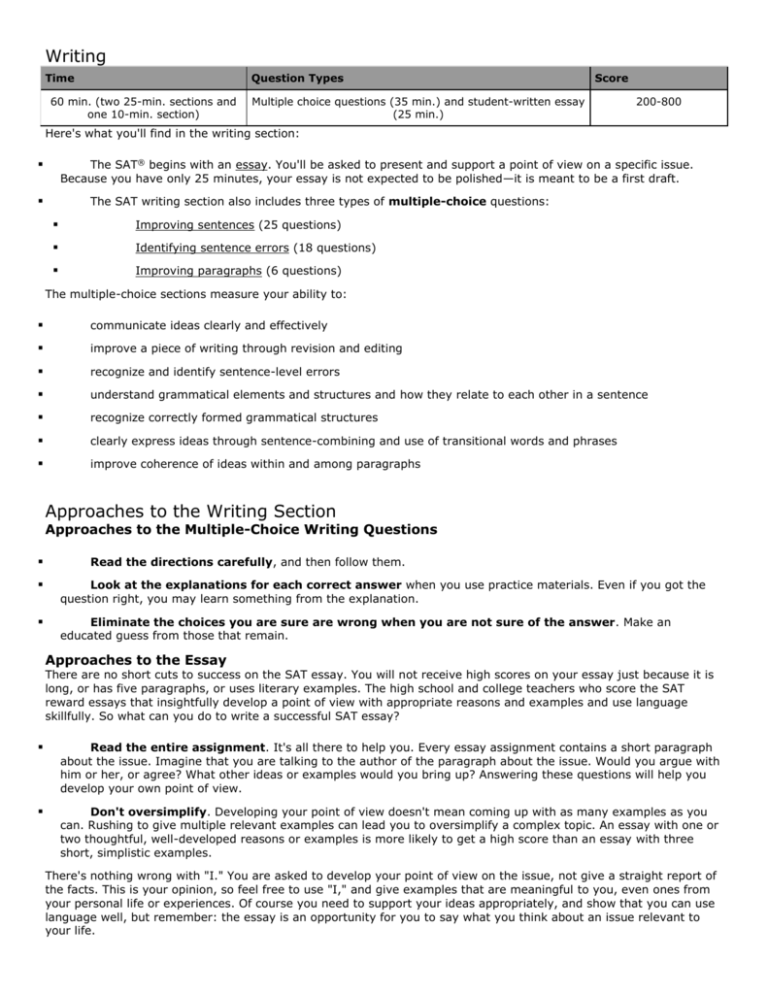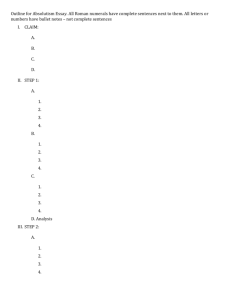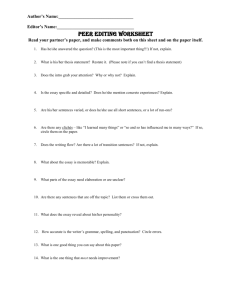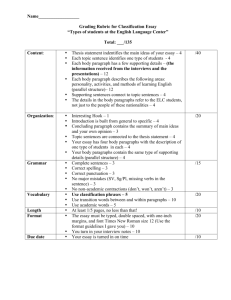Writing
advertisement

Writing Time Question Types 60 min. (two 25-min. sections and one 10-min. section) Score Multiple choice questions (35 min.) and student-written essay (25 min.) 200-800 Here's what you'll find in the writing section: The SAT® begins with an essay. You'll be asked to present and support a point of view on a specific issue. Because you have only 25 minutes, your essay is not expected to be polished—it is meant to be a first draft. The SAT writing section also includes three types of multiple-choice questions: Improving sentences (25 questions) Identifying sentence errors (18 questions) Improving paragraphs (6 questions) The multiple-choice sections measure your ability to: communicate ideas clearly and effectively improve a piece of writing through revision and editing recognize and identify sentence-level errors understand grammatical elements and structures and how they relate to each other in a sentence recognize correctly formed grammatical structures clearly express ideas through sentence-combining and use of transitional words and phrases improve coherence of ideas within and among paragraphs Approaches to the Writing Section Approaches to the Multiple-Choice Writing Questions Read the directions carefully, and then follow them. Look at the explanations for each correct answer when you use practice materials. Even if you got the question right, you may learn something from the explanation. Eliminate the choices you are sure are wrong when you are not sure of the answer. Make an educated guess from those that remain. Approaches to the Essay There are no short cuts to success on the SAT essay. You will not receive high scores on your essay just because it is long, or has five paragraphs, or uses literary examples. The high school and college teachers who score the SAT reward essays that insightfully develop a point of view with appropriate reasons and examples and use language skillfully. So what can you do to write a successful SAT essay? Read the entire assignment. It's all there to help you. Every essay assignment contains a short paragraph about the issue. Imagine that you are talking to the author of the paragraph about the issue. Would you argue with him or her, or agree? What other ideas or examples would you bring up? Answering these questions will help you develop your own point of view. Don't oversimplify. Developing your point of view doesn't mean coming up with as many examples as you can. Rushing to give multiple relevant examples can lead you to oversimplify a complex topic. An essay with one or two thoughtful, well-developed reasons or examples is more likely to get a high score than an essay with three short, simplistic examples. There's nothing wrong with "I." You are asked to develop your point of view on the issue, not give a straight report of the facts. This is your opinion, so feel free to use "I," and give examples that are meaningful to you, even ones from your personal life or experiences. Of course you need to support your ideas appropriately, and show that you can use language well, but remember: the essay is an opportunity for you to say what you think about an issue relevant to your life. Improving Sentences This question type measures your ability to: recognize and correct faults in usage and sentence structure recognize effective sentences that follow the conventions of standard written English Directions The following sentences test correctness and effectiveness of expression. Part of each sentence or the entire sentence is underlined; beneath each sentence are five ways of phrasing the underlined material. Choice A repeats the original phrasing; the other four choices are different. If you think the original phrasing produces a better sentence than any of the alternatives, select choice A; if not, select one of the other choices. In making your selection, follow the requirements of standard written English; that is, pay attention to grammar, choice of words, sentence construction, and punctuation. Your selection should result in the most effective sentence— clear and precise, without awkwardness or ambiguity. Example: Laura Ingalls Wilder published her first book and she was sixty-five years old then. (A) and she was sixty-five years old then (B) when she was sixty-five (C) at age sixty-five years old (D) upon the reaching of sixty-five years (E) at the time when she was sixty-five Answering Improving Sentences Questions Look carefully at the underlined portion of the sentence because it may have to be revised. Keep in mind that the rest of the sentence stays the same. Follow the two outlined steps in answering each Improving Sentences question. Step 1: Read the entire sentence carefully but quickly and ask yourself whether the underlined portion is correct or whether it needs to be revised. In the example above, connecting the two ideas ("Laura Ingalls Wilder published her first book") and ("she was sixty-five years old then") with the word "and" indicates that the two ideas are equally important. The word "and" should be replaced to establish the relationship between the two ideas. Step 2: Read choices (A) through (E), replacing the underlined part with each answer choice to determine which revision results in a sentence that is clear and precise and meets the requirements of standard written English. Remember that choice (A) is the same as the underlined portion. Even if you think that the underline does not require correction and choice (A) is the correct answer, it is a good idea to read each choice quickly to make sure. The word "and" indicates that the two ideas it connects are equally important. No. Replacing the word "and" with "when" clearly expresses the information that the sentence is intended to convey by relating Laura Ingalls Wilder's age to her achievement. Yes, but continue to look at the other revisions. Using the word "at" results in a phrase that is not idiomatic. No. The phrase "upon the reaching of" also results in a phrase that is not idiomatic. No. The phrase "at the time when she was sixty-five years old" is awkward and wordy. No. Correct answer: (B) Identifying Sentence Errors This question type measures your ability to: recognize faults in usage recognize effective sentences that follow the conventions of standard written English Directions The following sentences test your ability to recognize grammar and usage errors. Each sentence contains either a single error or no error at all. No sentence contains more than one error. The error, if there is one, is underlined and lettered. If the sentence contains an error, select the one underlined part that must be changed to make the sentence correct. If the sentence is correct, select choice E. In choosing answers, follow the requirements of standard written English. The other delegatesA and himB immediatelyC accepted the resolution draftedD by the neutral states. No errorE Answering Identifying Sentence Errors Questions Ask yourself if any of the underlined words and phrases in the sentence contains a grammar or usage error. Follow the two outlined steps in answering each Identifying Sentence Errors question. Step 1: Read the entire sentence carefully but quickly, paying attention to underlined choices (A) through (D). In the example above, "The other delegates and him" are the people who "immediately accepted the resolution," and the phrase "drafted by the neutral states" describes "the resolution." Check each underlined word or phrase for correctness. The phrase "The other" correctly modifies the word "delegates." The pronoun "him" is in the wrong case. (One would not say "him immediately accepted.") "Him" is an error, but go on to check the other choices, especially if you are not sure. The word "immediately," which modifies the verb "accepted," is correct. The phrase "drafted by" correctly expresses the action of the "neutral states." Step 2: Select the underlined word or phrase that needs to be changed to make the sentence correct. Mark (E) No error if you believe that the sentence is correct as written. Mark (B) on your answer sheet because the underlined word "him" must be changed to "he" to make the sentence correct. Correct answer: (B) Keep in mind that some sentences do not contain an error. Improving Paragraphs This type of question measures your ability to: edit and revise sentences in the context of a paragraph or the entire essay organize and develop paragraphs in a coherent and logical manner apply the conventions of standard written English Directions The following passage is an early draft of an essay. Some parts of the passage need to be rewritten. Read the passage and select the best answers for the questions that follow. Some questions are about particular sentences or parts of sentences and ask you to improve sentence structure or word choice. Other questions ask you to consider organization and development. In choosing answers, follow the requirements of standard written English. Answering Improving Paragraphs Questions To answer the Improving Paragraphs questions that accompany the draft essay, you will need to note what sentences need to be corrected and to know how the sentences relate to one another and to the essay as a whole. Follow the outlined steps to answer the questions. Step 1: Read the entire essay quickly to determine its overall meaning. The essay is intended as a draft, so you will notice errors. Step 2: In answering each question, make sure that your answer about a particular sentence or group of sentences makes sense in the context of the passage as a whole. Choose the best answer from among the choices given, even if you can imagine another correct response.







